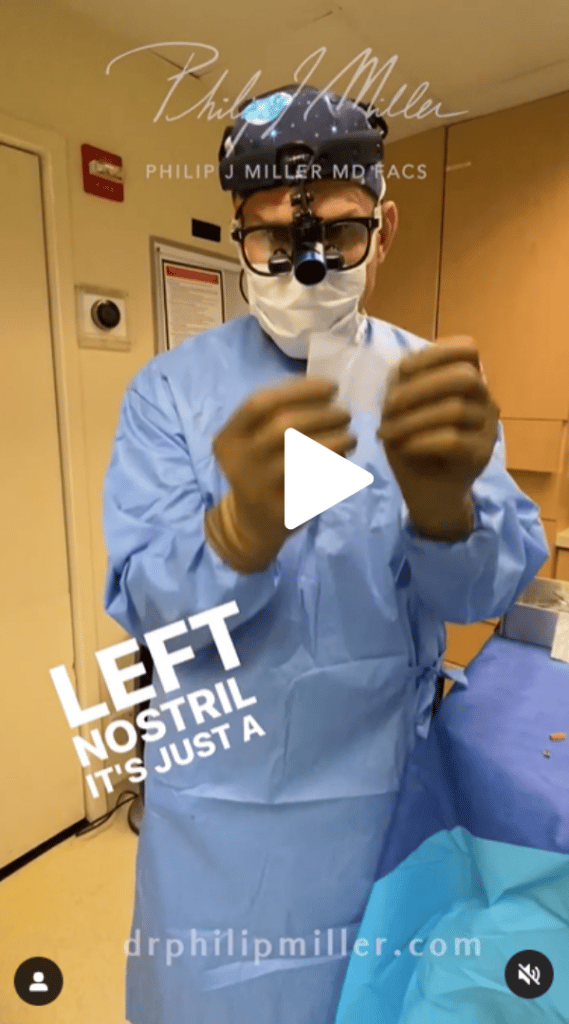Do I need rhinoplasty or septoplasty?
Noses can have a range of issues that patients want corrected. Septoplasty and rhinoplasty are two common surgical procedures used to correct various nasal abnormalities. Despite being similar in name, the two procedures are actually quite different. A septoplasty focuses on the internal structure of the septum to correct functionality, while a rhinoplasty focuses more on the outer appearance and aesthetics of the nose.
While both procedures are centered around the nose, each method has a designated goal and outcome that can provide patients with a better-looking and functioning nose. Do you need rhinoplasty or septoplasty? Take a look:
Rhinoplasty vs septoplasty: what’s the difference?
Septoplasty is a common procedure to correct breathing problems, and rhinoplasty is used to correct aesthetic features like nose shape and size. Septoplasty is used to correct septal deviations. The septum is the cartilage that separates the nasal passages. When this cartilage shifts to the side, known as a deviated septum, it can affect your ability to breathe easily and lead to nasal blockages and frequent nosebleeds. Septoplasty realigns the septum to achieve symmetry in the nasal cavities and improve nasal function.
A rhinoplasty, also known as a nose job or nose reshaping surgery, is used to improve the appearance of the nose. Many patients feel the shape or size of the nose detracts from other facial features, and a nose job can make minor changes or reconstruct an entire nose to make it fit harmoniously with other facial features. It is a highly complex procedure that can be personalized to fit each patient’s desires and aesthetic beauty goals.
While they have their differences, septoplasty and rhinoplasty are both surgical procedures that require the care and expertise of a board-certified facial plastic surgeon. It is critical to work with a surgeon that has years of experience to ensure your results are seamless and natural.
When to choose rhinoplasty?
Although rhinoplasty is a popular cosmetic procedure, it is not for everyone. You may be a candidate for rhinoplasty if you:
- Are in good overall health
- Want to improve facial balance
- Have an irregularity like a bulbous tip
- Want to address ethnic nose characteristics
A rhinoplasty can address many irregularities, including:
- Size of the nose
- Shape of the nasal tip
- Wide or narrow nostrils
- Angle of the nose
- Nose and upper lip that are too close together
- Hooked or crooked nose
- Hump or bump
- Nose asymmetry
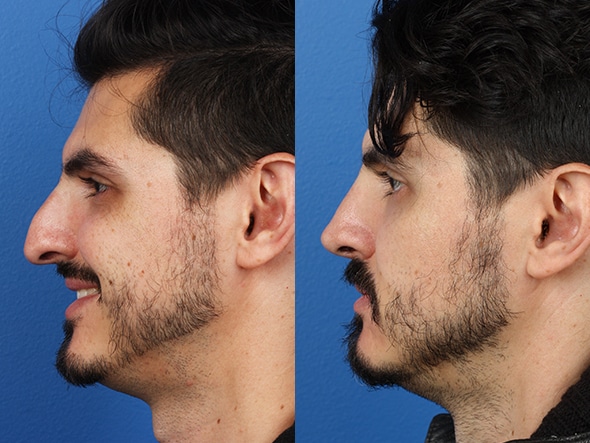
When to choose septoplasty?
You may be a candidate for septoplasty if you experience:
- Excessive snoring
- Sleep apnea
- Recurrent sinusitis
- Breathing difficulties
- Respiratory complaints
- Deviated septum due to injury or trauma
Septoplasty has many benefits associated with clearing the nasal passage, including:
- Uninterrupted breathing patterns
- Better sleep
- Improved airflow
- Self-maintained airways and drainage passageways
- Reduced sinus infections
- Improved smell and taste
Can I get rhinoplasty with septoplasty at the same time?
Yes, rhinoplasty with septoplasty is a common surgical combination. Having rhinoplasty and septoplasty at the same time is a popular choice for patients in need of improved functionality and appearance. It allows you to receive the best of both worlds – the improved breathing offered by septoplasty while adjusting cosmetic irregularities like a hump or bulbous tip. It is safe and effective to correct all issues with one procedure to reduce recovery time and ensure all changes are cohesive.
Your expert facial plastic surgeon should comprehensively evaluate your needs to determine if you need septoplasty and rhinoplasty procedures to achieve your desired results and eliminate any functional issues you might have. There are several benefits to having the procedures done together, such as:
- One surgical cost
- One recovery time
- Convenience
- Possible insurance coverage for the septoplasty portion of the procedure
- Better outcomes aesthetically and functionally
Septoplasty and rhinoplasty surgeon in New York
Philip J. Miller, MD, FACS, is a world-renowned plastic surgeon who is double board-certified in facial plastic and reconstructive surgery of the head and neck. He has more than 20 years of experience with facial plastic surgery and is considered a leading expert in rhinoplasty and facial rejuvenation. He is a highly acclaimed surgeon offering custom treatment plans to help patients meet their aesthetic goals.
Dr. Miller uses the NatraLook® process, an enriching experience that allows patients to explore their confidence in a safe and supportive environment. He creates a unified vision with patients by discussing their personal desires and obstacles. Contact us to schedule a consultation and learn more about septoplasty and rhinoplasty.
I Hate My Nose After Rhinoplasty: What to Do?
If you’re having some regrets after your rhinoplasty, keep in mind final results won’t present themselves right away. You’re not going to be able to see the true aesthetic results of your rhinoplasty until it’s fully healed, which will take up to a year or longer.
But what about when you’ve healed from your original procedure, and you still regret your rhinoplasty? Let’s dive into some of the reasons why this might happen, and what you can do about it – especially if you can get to Manhattan, New York or New Orleans, Louisiana for revision rhinoplasty.
Is it normal to not like your nose after rhinoplasty?
If you’ve been watching your rhinoplasty heal over time and you’re still thinking “I don’t like my nose”, it’s not unheard of. As many as 10-15% of cosmetic nose surgeries result in unhappy clients who will choose to undergo a second procedure to fix it. This commonly occurs for a few reasons:
- You may have trusted an inexperienced surgeon with inferior talent, resulting in lackluster nose surgery results. Rhinoplasty is one of the most complex of all facial plastic surgeries, requiring a great deal of precision, skill, and artistry to perform correctly. This is one reason why so many rhinoplasty procedures result in revisions.
- A lack of communication between you and your doctor may have led to bad rhinoplasty results. Many failed nose jobs stem from the doctor thinking that their patient was looking for something that they didn’t express.
- Complications can present themselves during the procedure or healing process that can lead to a bad rhinoplasty result overall.
- Even in the best of hands and the most simple of procedures, rhinoplasty is not an entirely predictable operation as there are many factors after the surgery that play a role in forming the final result that you and your surgeon have no control over.
When does your nose stop changing after a nose job?
There are a variety of rhinoplasty changes that occur over time during your healing process. That’s part of why it’s strongly encouraged to hold off on a revision rhinoplasty until you can see the full results after 12-18 months of healing. Until that time, the final form or function of the nose won’t be apparent.
Swelling and unactualized results may make your nose seem too big, too short, look the same as it did before, look fat, or feel weird after rhinoplasty. This can lead to post-rhinoplasty depression – but if you let yourself heal, you will find you have options to improve your results.
What Do I Do If I’m Unhappy with My Rhinoplasty?
After you’ve given your nose adequate time to heal, what happens if you’re still unhappy with the results? First, let’s go through the types of issues that commonly manifest as undesirable results, or a nose job fail.
Pinched Tip
This happens when too much cartilage is removed from the tip of the nose, leading to less than ideal aesthetic results. This can also reduce functionality, leading to breathing troubles. Over time, a lack of support to the tip will result in a collapse of the shape of the nostrils.
Here’s a correction of a nasal tip through a revision rhinoplasty performed by Dr. Miller:
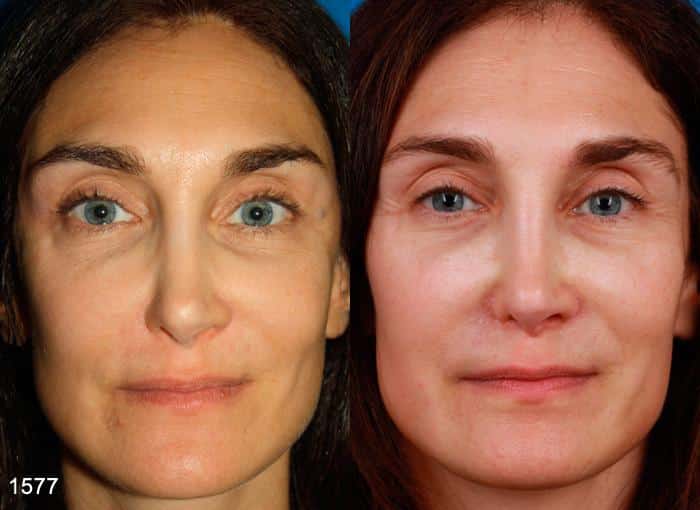
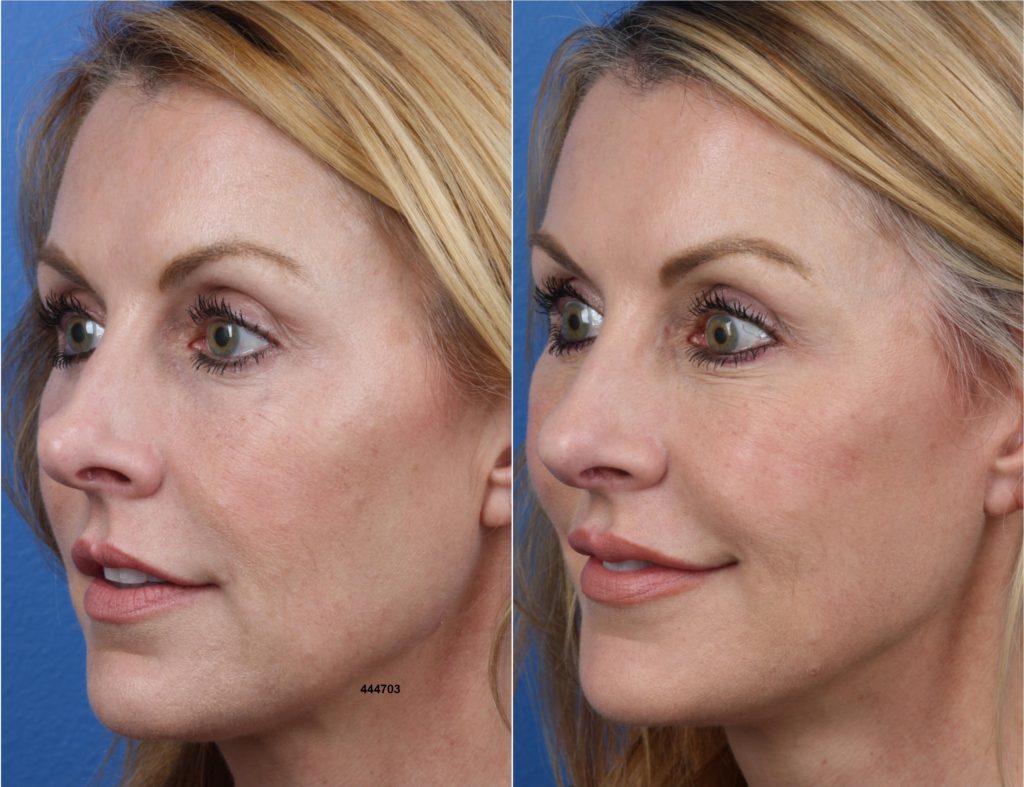
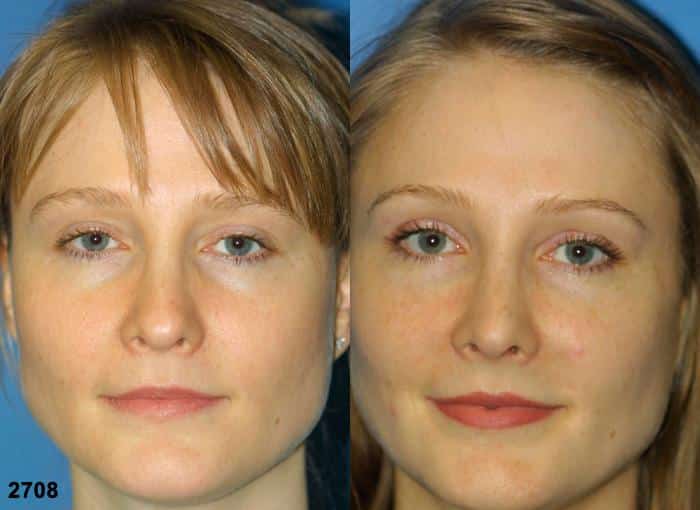
Short Nose
If too much cartilage is removed during the initial rhinoplasty, the appearance of a “short nose” may result. Through the use of specialized grafts and reinstating cartilage, a more natural-looking shape can be returned to the nose with a revision rhinoplasty.
Here’s an example of some of Dr. Miller’s work in this area:
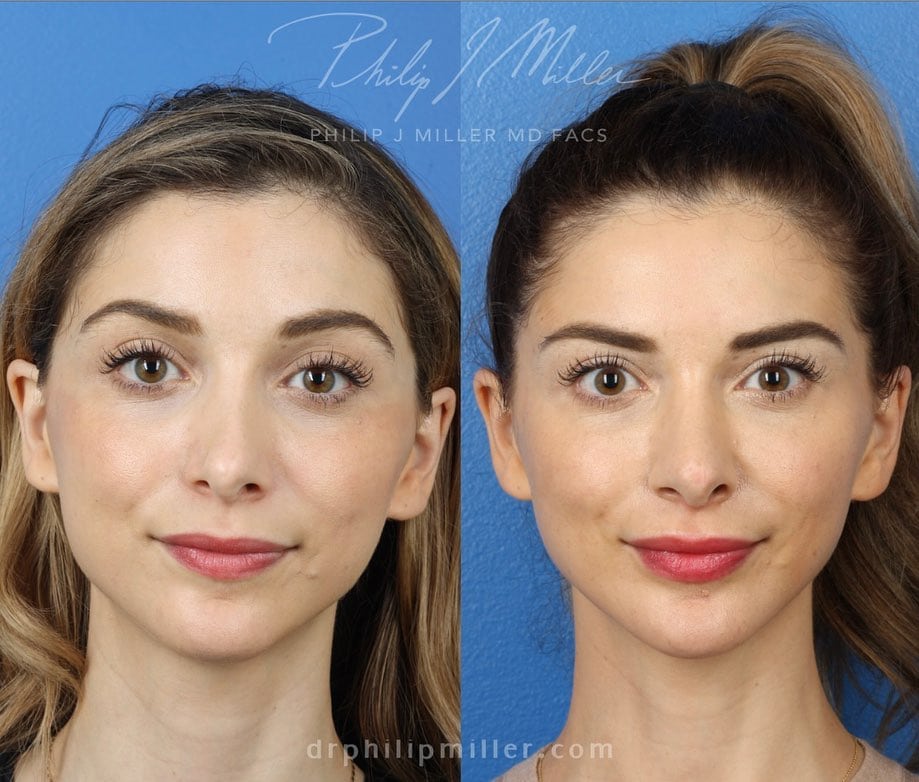
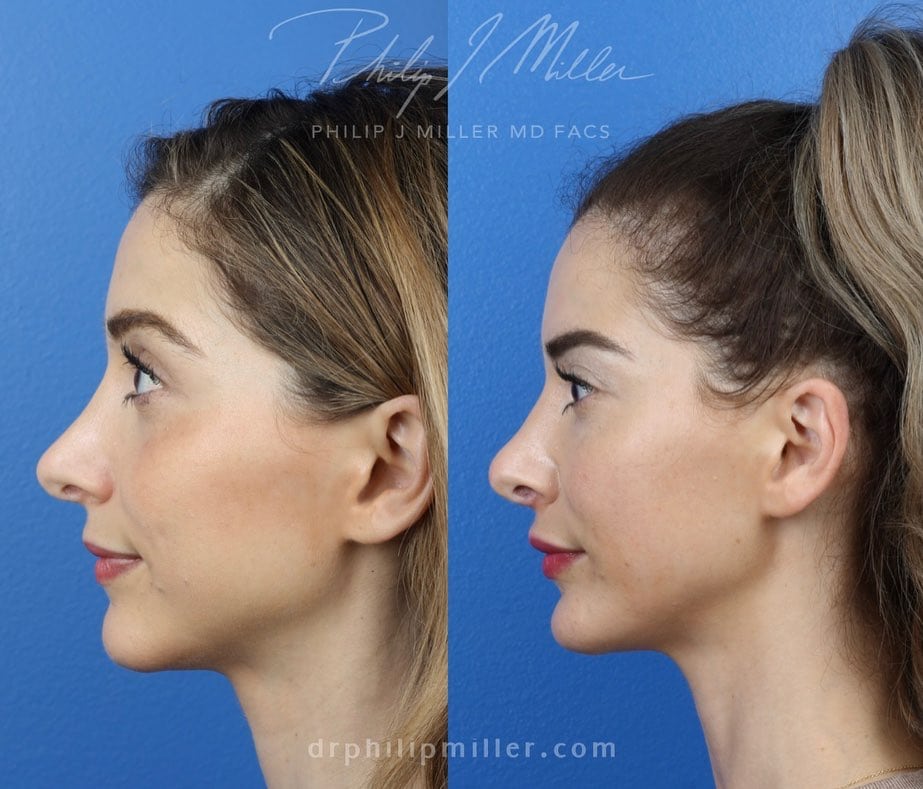
Crooked/Twisted Bridge
A “crooked” or “twisted” appearance can occur as a result of nasal trauma. This can be corrected by making the nose symmetrical again by rearranging the cartilage and the bone.
Here are some examples of Dr. Miller’s work that focus on symmetry:
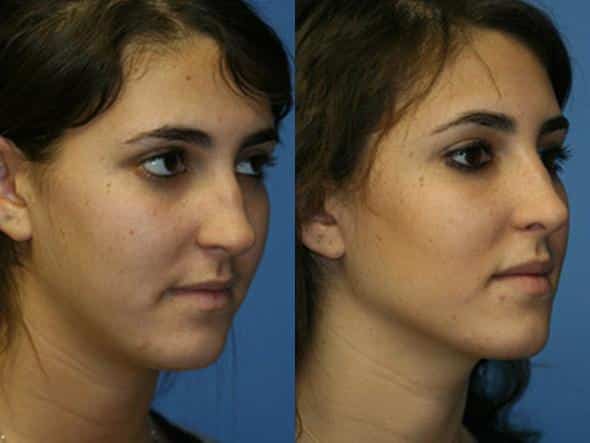
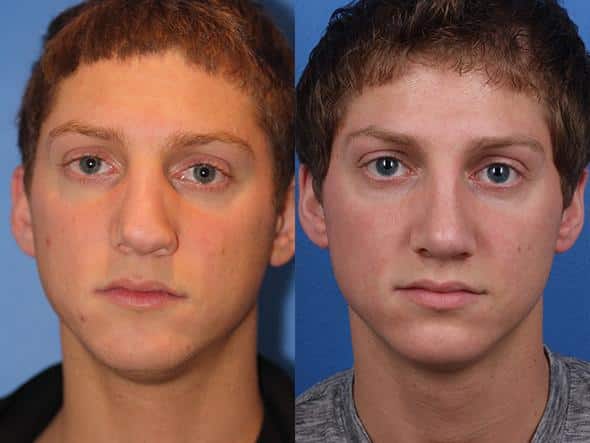
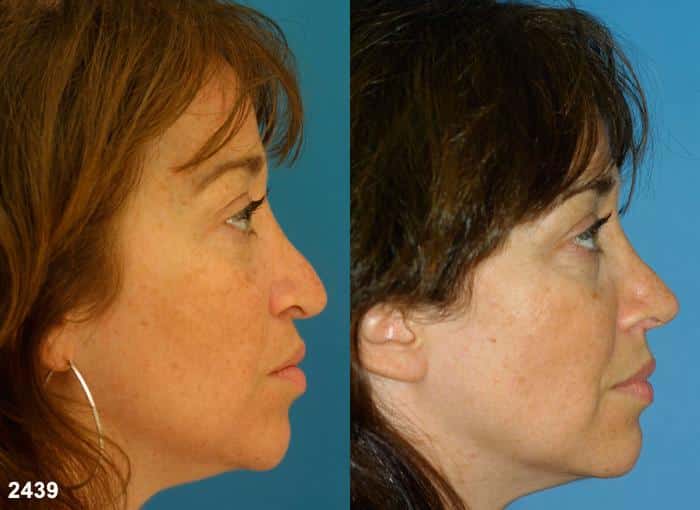
How to tell your plastic surgeon you are unhappy?
After going through the emotionally and physically exhaustive process of planning and completing your initial rhinoplasty, it can seem daunting to consider going through those steps again. After experiencing a bad nose surgery, you wouldn’t want to spend that time and money again for another rhinoplasty fail. However, the first logical step is to address your concerns with the surgeon who performed your initial surgery.
If your original surgeon cannot provide you with a satisfactory response to your issues, you may need to look for another surgeon to perform revision rhinoplasty for you. The most important factor here is the plastic surgeon you choose.
A board-certified facial plastic surgeon is often the best choice for a revision rhinoplasty procedure. These specialists have intimate knowledge of the nose, studying first as an ear, nose, and throat specialist. The addition of plastic surgery training ensures these surgeons have both the expertise and the artistry to enhance the appearance of the nose while preserving function.
How Can I Fix My Rhinoplasty?
Philip J. Miller, MD, FACS, is a board-certified facial plastic surgeon who specializes in procedures for the nose and face. He offers his proprietary NatraLook® Process, which is a patient-centric approach to understanding your needs, listening to your expectations, and going through every step with communication and trust. With a technique that combines artistry and science, Dr. Miller has performed over 5,000 successful surgeries.
You need a surgeon with proven abilities, who has achieved a high success rate in producing the most natural-looking and aesthetically-pleasing rhinoplasty results in Manhattan, New York, and New Orleans, Louisiana. Schedule your consultation with Dr. Miller today by calling 646-791-3025, or booking online.
Learn how rhinoplasty can make a nose appear smaller here.
5 Rhinoplasty Trends in 2022
Rhinoplasty surgery was the most frequently requested cosmetic surgery in 2020, with over 352,000 procedures performed.
Facial plastic surgeon, Dr. Philip Miller in New York City—one of the country’s leading experts in rhinoplasty and facial rejuvenation—can help you achieve a nose you’ll love. You may choose traditional rhinoplasty to reduce or reshape the nose. For other patients, non-surgical rhinoplasty is the right choice to achieve their aesthetic goals.
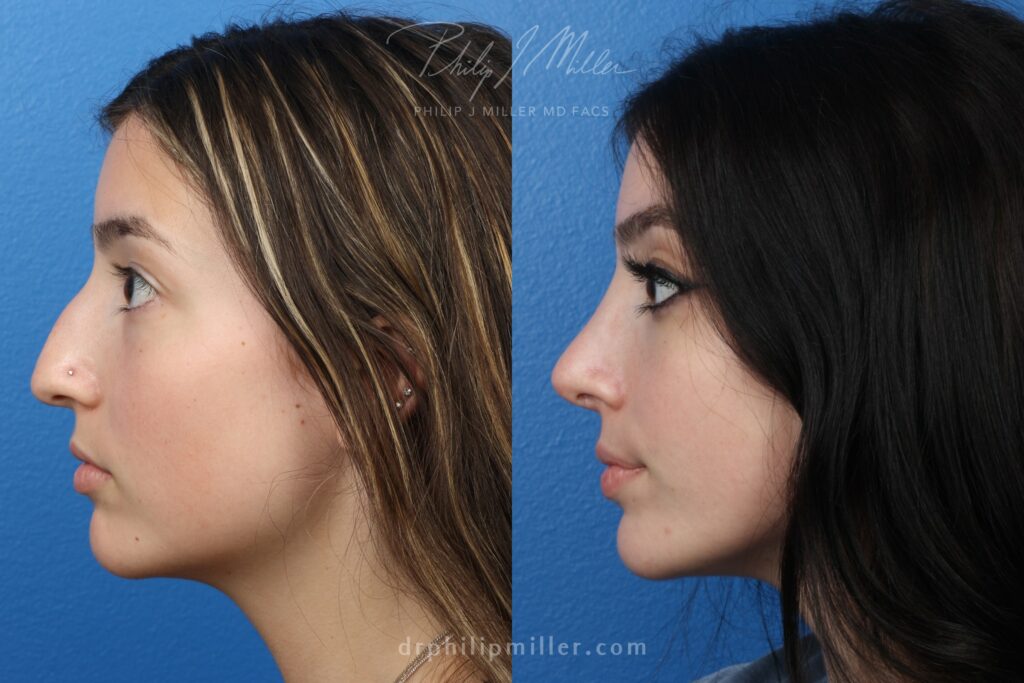
1. Zoom Boom Brings Rhinoplasty Boom
Because of the COVID-19 pandemic, 2020 was a challenging year for many businesses. But for Zoom, the video-conferencing giant, lockdown and working from home brought unprecedented growth.
Zoom usage jumped 67% between January 2020 and mid-March, when non-essential businesses and schools closed. The Zoom Boom also resulted in significant growth to an entirely different industry—cosmetic surgery.
The built-in cameras on our computers are clearly not designed to flatter the human face, and many people weren’t pleased with the reflection they saw on their computer screens.
The unflattering camera angle highlights facial flaws, such as wrinkling and sagging. People noticed unfamiliar lines, creases, and asymmetries as they saw themselves speaking on camera.
It’s not surprising that the Zoom phenomenon caused a booming demand for cosmetic procedures such as dermal injectables, laser treatments, and eye lifts.
On a Zoom conference call, the position of the computer’s camera relative to the user puts the focus on the center of the face, making the nose appear larger. As a result, demand for rhinoplasty significantly increased as well, and will likely continue into the New Year.
2. The Need for Natural
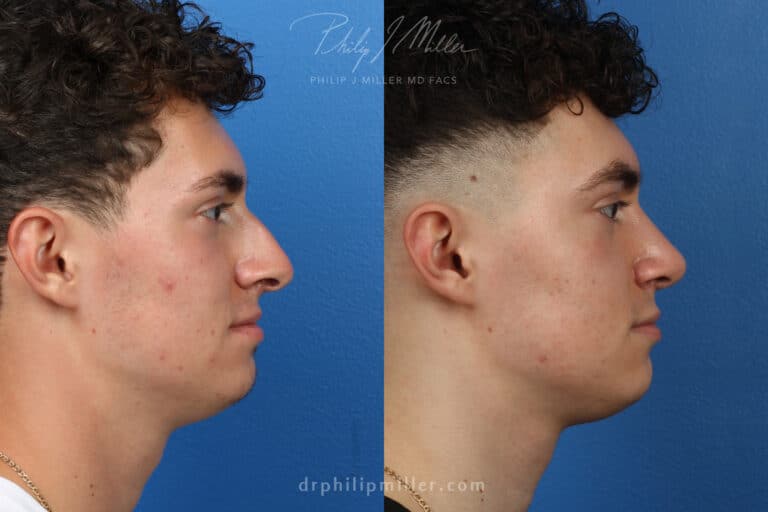
In Manhattan, Dr. Miller is renowned for the natural results he achieves for his patients, both with traditional rhinoplasty—for patients desiring more significant changes and permanent results—as well as non-surgical rhinoplasty, for patients seeking relatively minor corrections. As demands for natural results will continue to be a factor in 2022, Dr. Miller is prepared to deliver satisfying results to his New York patients.
Rhinoplasty, also known as a nose job, is a surgical procedure that can improve the appearance of the nose by reshaping, reducing, augmenting the tissue, removing a bump, or adjusting the angle between the nose and the mouth.
A major benefit of rhinoplasty is that it’s typically a “one-and-done” procedure. Once the surgery is complete and the nose has fully healed, patients can enjoy the improvements over their lifetime.
If you’re dissatisfied with your nose because of minor depressions or hollows that affect its overall appearance, non-surgical rhinoplasty may be the right solution for you. Non-surgical nose jobs are safe and effective, providing immediate results with exceptionally short recovery time. With this non-invasive procedure, injectable fillers are used to make small yet dramatic modifications to the nose.
Non-surgical rhinoplasty has its limitations, however. Since corrections are made with dermal fillers that ultimately dissolve, results aren’t permanent. Non-surgical nose jobs aren’t appropriate for every nose and can’t reduce the size of the nose.
Results will vary by patient, but the longevity of a non-surgical nose job is typically between 8-24 months. During your consultation, Dr. Miller will determine which fillers might help you achieve the best results and how long the improvement might last.
3. Faster Recovery Times
Plastic surgeons today are starting to use techniques to minimize post-procedure discomfort and healing time. Rhinoplasty is typically performed as an outpatient procedure under general anesthesia, and patients return home on the same day. While you may be up and moving within 24 hours, expect to take up to a week off from work or school as you heal.
For the first several days, you’ll need to keep your head elevated and apply ice packs to reduce swelling. Most swelling and bruising subsides within a week following rhinoplasty. Nasal dressings, splints, and sutures are removed at about seven days after surgery. At this point, any residual bruising can be effectively camouflaged with makeup. Most patients feel comfortable appearing in public at about 7-10 days post-surgery.
Swelling will continue to subside and the nose may continue to improve in definition for up to a year after surgery. However, beyond the first week, these changes are subtle and typically not noticed by others. Many patients are pleasantly surprised at how quickly they recover from rhinoplasty.
4. The Combination Approach
Achieving facial balance sometimes means making adjustments to the chin at the same time as the nose. Dr. Miller’s expertise with both procedures produces superior results.
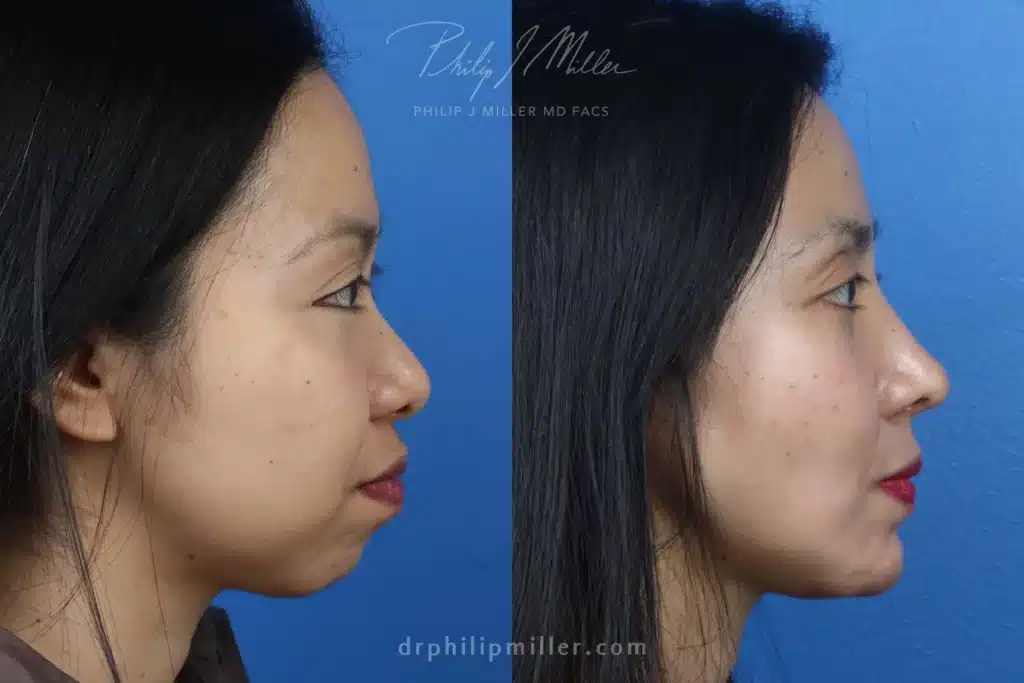 When rhinoplasty surgery is performed to improve the overall shape and appearance of a nose, a receding chin could diminish the aesthetic effect of the face, making it look unbalanced.
When rhinoplasty surgery is performed to improve the overall shape and appearance of a nose, a receding chin could diminish the aesthetic effect of the face, making it look unbalanced.
To achieve the best possible results with rhinoplasty, the proportions of the entire face must be considered. If your chin is well defined and proportionate to your new nose, your overall appearance will be aesthetically enhanced by rhinoplasty alone.
If you have a receding chin, however, chin augmentation surgery performed along with rhinoplasty surgery can give your face balance that rhinoplasty alone could not have achieved. Therefore, many board-certified plastic surgeons are beginning to suggest chin augmentation with rhinoplasty for certain patients.
Recovery after a chin implant takes around two weeks. You may experience swelling, tenderness, and bruising in the chin area immediately after the procedure, but most of these symptoms will diminish within about a week. Eating soft foods during the first week after surgery will help to make your recovery period more comfortable.
5. Image Morphing
The ability to “see” your results before surgery is a benefit that more patients are wanting from their rhinoplasty surgeon. At his Manhattan office, Dr. Miller uses computer imaging to help patients visualize their new nose before undergoing surgery. Besides helping communicate the goals of the patient to the surgeon before the procedure, image morphing also helps ensure patient expectations are in line with results.
If you have difficulty visualizing what your ‘after’ may look like, image morphing can help. While the final result may not be absolutely identical to the morphed picture, it provides a good idea of what you can expect.
The NatraLook Process
Aesthetic Confidence is the sense of empowerment we feel about the way we look, dress, design, and decorate. It dovetails with confidence in our abilities, intellect, and emotions. The NatraLook Process focuses exclusively on the look component of Aesthetic Confidence. The NatraLook Process is an enriching experience through which you explore and ultimately boost your aesthetic confidence by enhancing your appearance.
The NatraLook process evaluates and expands the typical plastic surgery experience into a safe, non-intimidating opportunity to explore your aesthetic confidence. It creates a unified vision of your desired result so that you and New York surgeon Dr. Philip Miller know what to expect.
Contact an Expert Plastic Surgeon to Learn More About Rhinoplasty in New York City
Whichever procedure you ultimately choose, Dr. Miller can help you achieve your goals. His approach combines art and science with skill and innovation, providing patients in Manhattan, New York, aesthetically pleasing, natural results that are always in style.
To learn more about rhinoplasty surgery and non-surgical nose jobs, contact us online or call our practice in New York. One of our patient advisers will be happy to help you.
7 Questions to Ask Your Facelift Surgeon
A facelift may smooth sagging skin and tighten the tissue underneath the skin to give your face a fresh look. If you desire a more permanent improvement to the features of your face, a facelift may produce the beautiful glow that boosts your confidence and lifts your spirits. If you have questions about something as important as facelift surgery, don’t be afraid to ask your surgeon what you desire to know.
Dr. Philip Miller is your Manhattan, New York, and New Orleans, Louisiana, expert on all types of facelift surgery especially deep plane facelift surgery. He is a double board-certified facial plastic surgeon who will answer every question you have about this procedure. The following seven questions are frequently asked by people who choose to undergo facelift surgery. When you schedule your consultation with Dr. Miller, have your questions ready so you are prepared to move forward if you decide a facelift is the right choice for you.

1. Am I a good candidate for a facelift?
Facelift surgery is not a procedure you should decide to schedule on the spot. You should do your homework, research your options, and choose a surgeon who specializes in facial plastic surgery. Dr. Miller will provide you with a comprehensive consultation to determine if you are a good candidate for a facelift. There is no “perfect” age for a facelift – when you look in the mirror and see skin laxity, creases, and facial hollowing that indicate you need a change, that is when you need to schedule your consultation. Dr. Miller can help you determine if facelift surgery or another procedure is the best option.
2. How often do you perform this procedure?
Dr. Miller has focused on facial procedures for over two decades. That means all of his time goes into treatments for the face, while a general plastic surgeon might divide time between the face and body procedures. His double board-certification and expertise in facial plastic surgery are also a guarantee that you will receive the best attention for your needs.
3. What type of facelift will work best for me?
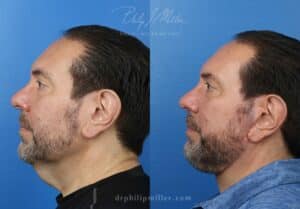
There are several options with facelift surgery, so during your consultation with Dr. Miller, you will learn about the different types of surgery that meet your needs. Based on the results you desire, you may choose the traditional facelift, or a procedure like the micro or mini facelift that are less invasive and a good option for earlier signs of aging. No matter which facelift you choose, Dr. Miller’s NatraLook consultation process will ensure you build trust with your surgeon and receive professional, expert advice from one of the country’s leading experts on facial plastic surgery.
Doctor Miller routinely performs the preferred deep plane facelift as it gives the most natural redraping of descended tissue and restores depleted volume.
Deep Plane Facelift
Dr. Miller performs the deep plane facelift to restore sagging midface tissue and volume depletion. The deep plane is different than the traditional facelift as it extends the flap further toward the upper midface so that sagging tissue in the cheek and jowl region can be rejuvenated. Not all patients require a deep plane lift, but for those that do, no other surgery can compare.
Traditional Facelift
Dr. Miller performs the traditional facelift procedure by making intricate incisions on your hairline, in front of your ears, and behind your ears near the lower part of your scalp line. Based on your desired look, Dr. Miller will redistribute fat through these incisions, and may also use liposuction to remove additional fat. Don’t worry – the incisions are concealed so visible scarring is minimal afterward. Your incisions will be closed with sutures, and based on the complexity of your facelift, you may have drains in place that can be removed in a couple of days. You will follow up with Dr. Miller in 5-10 days for suture removal. To learn more about a traditional facelift, please visit medlineplus.gov.
Mini Facelift
The mini facelift is another effective option that targets earlier signs of aging. This technique is designed to target specific areas of the face at the onset of wrinkling or sagging. Dr. Miller will make his incisions at the front of the ear, but not behind the ear. The procedure does not require general anesthesia; you will receive a local anesthetic and be done in about 90 minutes.
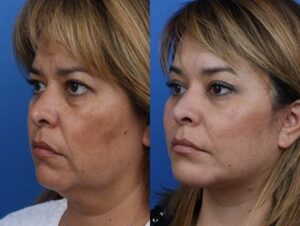
4. Where and how will you perform my procedure?
Dr. Miller performs all facelift procedures in the surgical suite of his Manhattan office. The surgery suite is accredited and adheres to the strict standards set forth by the Joint Commission.
Surgery, whether minor or major, will require local (focused on a specific region) or general (surgery while you are asleep) anesthesia. Depending on the type of facelift you are scheduled for will determine the type of anesthesia used, and will be discussed during your consultation. Traditional and mini facelifts – both designed to give you a fresh new look, are performed differently, and are tailored to your precise needs and goals. Dr. Miller performs a variety of facelift techniques, to ensure your results are beautifully natural and distinctly you.
5. What happens after surgery? What will my recovery look like?
Your recovery is a process of resting and healing to ensure you see the best results. If you had general anesthesia, you may remain in our surgical suite for a short period to allow the effects of general anesthesia to wear off before you leave. A local anesthetic may produce numbness but will wear off soon after the procedure is complete. Make sure you have a ride home after your surgery with a friend or family member who can stay with you for the first 24 hours of your recovery if possible.
Recovering at Home
You will be sent home with dressings in place to protect the incisions and sutures. Drains may also help to drain fluid from the surgical site. Soreness and tightness on your face are normal after surgery.
Facelift surgery of any kind may produce some swelling or bruising. If you experience any unexpected symptoms, do not hesitate to contact Dr. Miller’s office right away. Rest assured that Dr. Miller will also keep in touch with you during your recovery process and through your post-operative appointments.
You may receive a prescription for pain medication prior to your surgery, but many of Dr. Miller’s patients report they did not require the medication as their recovery was more comfortable than expected.
Your recovery time may not be textbook, but most people can return to work and normal activities within a couple of weeks. Excessive activities, such as exercise or heavy lifting are not recommended for about a month after your surgery. During your recovery at home, stay active (but not too active!) to ensure your blood circulation is promoting the healing process. You will be instructed to avoid medications like aspirin or other blood thinners, as these can cause excessive bleeding after your surgery.
One of the most important parts of your recovery is following the instructions provided by Dr. Miller. His guidance will provide you with a step-by-step overview of how to prepare for your surgery, what to expect during and after surgery, and how to recover properly by caring for your incisions. Make sure you keep all of your scheduled follow-up appointments, and in time, you will see the benefits of your surgery with a refreshed, more youthful appearance.
6. What can I expect from my results?
You may be wondering about the results of your facelift – how will I look? Dr. Miller is a double-board certified facial plastic surgeon, the best you can ask for with facelift surgery. You may see as much as 10 years taken off, but one of the best testimonials for facelift surgery are the before and after photos. Dr. Miller’s staff will take before and after photos so you can see the drooping and sagging disappear.
7. What will the cost of my procedure be?
The cost of your surgery varies depending on which facial procedure you choose. The details of the cost will be discussed during your consultation. You must also consider other costs associated with the surgery, which might include a facility fee, the surgeon and anesthesiologist fees, and any postoperative supplies you may need for recovery. Facelift surgery is considered cosmetic and elective (not medically necessary), and would not be covered by your insurance. Remember that the costs vary and are not inexpensive, but if a facelift is not in your range of affordability, Dr. Miller can recommend other procedures that may provide a similar look without the same cost.
Schedule a Facelift Consultation with NYC’s Top Facial Plastic Surgeon
Whether you choose a traditional, mini, micro, or other facelift procedure, Dr. Philip Miller can turn the clock back and give you a new look, a fresh face, and a reason to smile again. Schedule your consultation today.
